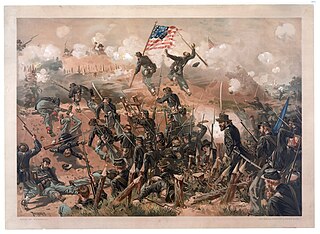
The Siege of Vicksburg was the final major military action in the Vicksburg campaign of the American Civil War. In a series of maneuvers, Union Major General Ulysses S. Grant and his Army of the Tennessee crossed the Mississippi River and drove the Confederate Army of Mississippi, led by Lieutenant General John C. Pemberton, into the defensive lines surrounding the fortress city of Vicksburg, Mississippi, leading to the successful siege and Confederate surrender.

The Army of the Tennessee was a Union army in the Western Theater of the American Civil War, named for the Tennessee River. A 2005 study of the army states that it "was present at most of the great battles that became turning points of the war—Fort Donelson, Vicksburg, and Atlanta" and "won the decisive battles in the decisive theater of the war."

Benjamin Henry Grierson was a music teacher, then a career officer in the United States Army. He was a cavalry general in the volunteer Union Army during the Civil War and later led troops in the American Old West.

John Alexander McClernand was an American lawyer, politician, and a Union Army general in the American Civil War. He was a prominent Democratic politician in Illinois and a member of the United States House of Representatives before the war. McClernand was firmly dedicated to the principles of Jacksonian democracy and supported the Compromise of 1850.

Frederick Steele was a career military officer in the United States Army, serving in the Mexican-American War, the Yuma War, and as a major general in the Union Army during the American Civil War. He was most noted for retaking much of secessionist Arkansas for the Union cause, escaping the besieged port-city of Camden through successful deception tactics, and defeating Sterling Price and E. Kirby Smith at Jenkins Ferry.
The 45th Regiment Illinois Volunteer Infantry, the "Washburn Lead Mine Regiment", was an infantry regiment that served in the Union Army during the American Civil War. In response to President Lincoln's call for 75,000 volunteers, it was organized at Galena, Illinois. It participated in many of the leading campaigns in the Western Theater.
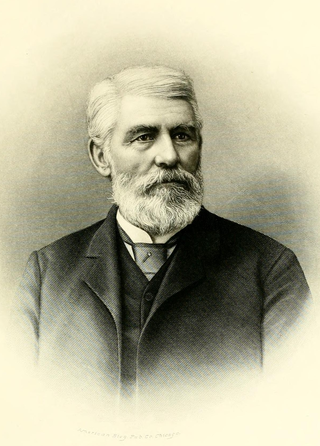
Charles Smith Hamilton was a career United States Army officer who served with distinction during the Mexican–American War. He also served as a Union Army general during the early part of the American Civil War. After the war, he was appointed U.S. marshal for the Eastern District of Wisconsin by President Ulysses S. Grant, and served as president of the University of Wisconsin Board of Regents.

Jacob Gartner Lauman was an American businessman from Iowa and a controversial general in the Union Army during the American Civil War.

Jasper Adalmorn Maltby was a general in the Union Army during the American Civil War. He participated in two important campaigns in the Western Theater, including the Vicksburg Campaign in 1863. A talented gunsmith, Maltby was the inventor of one of the first telescopic sights.
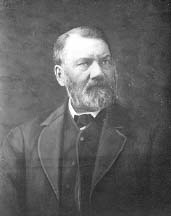
Benjamin Franklin Potts was an American lawyer, politician, and soldier from the state of Ohio who served as a general in the Union Army during the American Civil War, as well as a reconstruction era governor of the Montana Territory from 1870 to 1883. He commanded a brigade of infantry in the Western Theater in some of the war's most important campaigns and repeatedly received commendations for gallantry and tactical judgement in combat.
Isaac Campbell Pugh was a United States volunteer soldier who was a veteran of the Black Hawk War, the Mexican–American War and the American Civil War; rising to the rank of Brevet brigadier general.
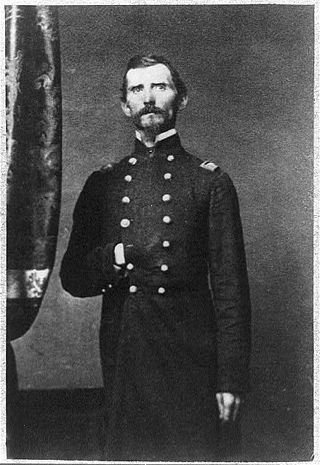
George Francis McGinnis was a volunteer soldier during the Mexican–American War and a Union General during the American Civil War.
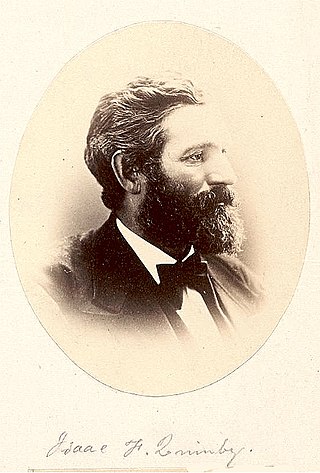
Isaac Ferdinand Quinby was a U.S. soldier and Union general during the American Civil War.

Leonard Fulton Ross was an American lawyer, probate judge, and stock raiser who served as a first lieutenant in the Mexican-American War and as a brigadier general during the American Civil War.
Charles Carroll Marsh was a Union Army officer during the American Civil War. He served with distinction early in the war at the battles of Fort Donelson and Shiloh. He is commonly referred to as "C. Carrol Marsh" in official reports.

On the onset of the American Civil War in April 1861, Ulysses S. Grant was working as a clerk in his father's leather goods store in Galena, Illinois. When the war began, his military experience was needed, and congressman Elihu B. Washburne became his patron in political affairs and promotions in Illinois and nationwide.
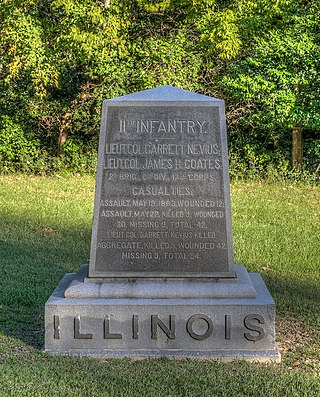
The 11th Regiment Illinois Volunteer Infantry was an infantry regiment from Illinois that served in the Union Army during the American Civil War. In April 1861, it was formed as a three-month volunteer unit, and in July 1861 it was reorganized as a three-year unit, in which role it served until the end of the war. Two of its commanding officers were promoted to brigadier general and led major units during the war. In its first major action at Fort Donelson the regiment suffered terrible losses. The 11th Illinois also fought at Shiloh, Riggins Hill, Vicksburg, First Yazoo City, Second Yazoo City, and Fort Blakely. In April 1863, the 109th Illinois Infantry Regiment was disbanded and its enlisted men transferred into the 11th Illinois. The regiment was mustered out of service in July 1865.
Adolph Engelmann was a farmer, lawyer, postmaster, Mexican–American War veteran, and Union Army colonel during the American Civil War. On May 18, 1866, the United States Senate confirmed his appointment as brevet brigadier general of volunteers.

Friend Smith Rutherford was a colonel in the Union Army during the American Civil War. He commanded the 97th Illinois Infantry Regiment during the Vicksburg campaign. On June 18, 1864, President Abraham Lincoln nominated Rutherford for appointment to the grade of brigadier general of volunteers and the United States Senate confirmed the appointment on June 28, 1864. Rutherford's appointment was dated June 27, 1864, and it was to rank from June 28, 1864. His appointment was made and commission issued without knowledge of his death on June 20, 1864. Since Rutherford had died, the confirmation technically could not be given and the commission could not become effective. Nonetheless, several sources list Rutherford as a Union Army general, although historian Ezra Warner does not.
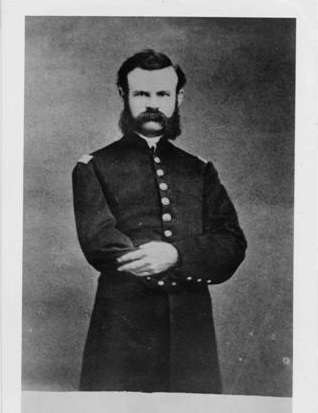
Battery F, 2nd Illinois Light Artillery Regiment was an artillery battery from Illinois that served in the Union Army during the American Civil War. The battery was organized in December 1861 at Cape Girardeau, Missouri. The unit fought at Shiloh, First Corinth, and Second Corinth in 1862 and at Vicksburg and Jackson in 1863. The battery served in the Atlanta campaign and at Nashville in 1864. It was mustered out of federal service in July 1865. The battery's first commander was John Wesley Powell who later led an exploration of the Grand Canyon.
















